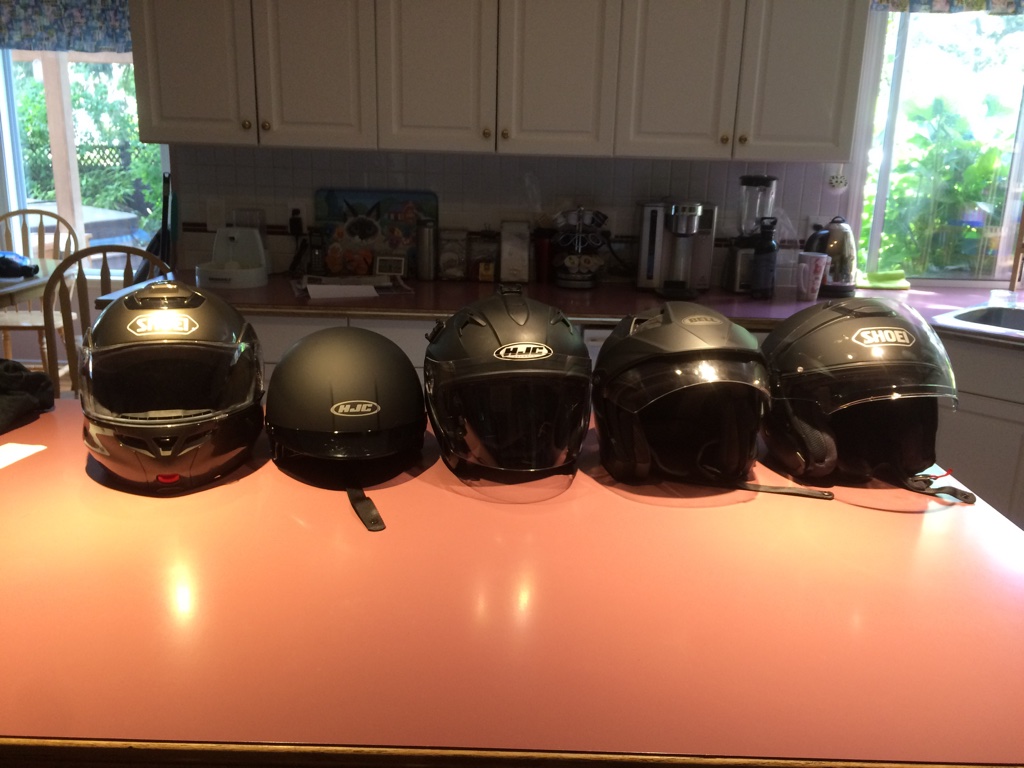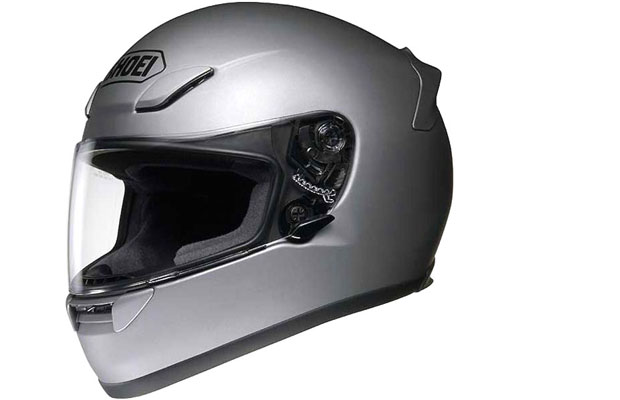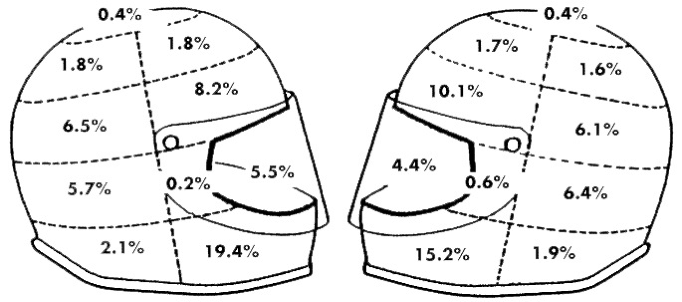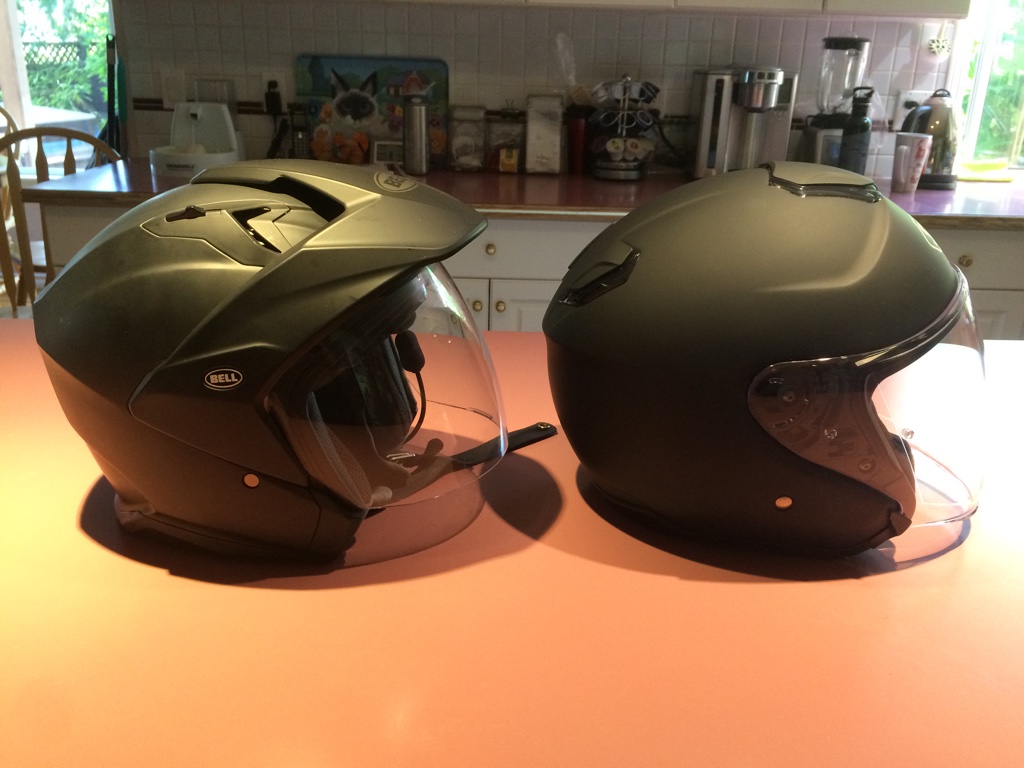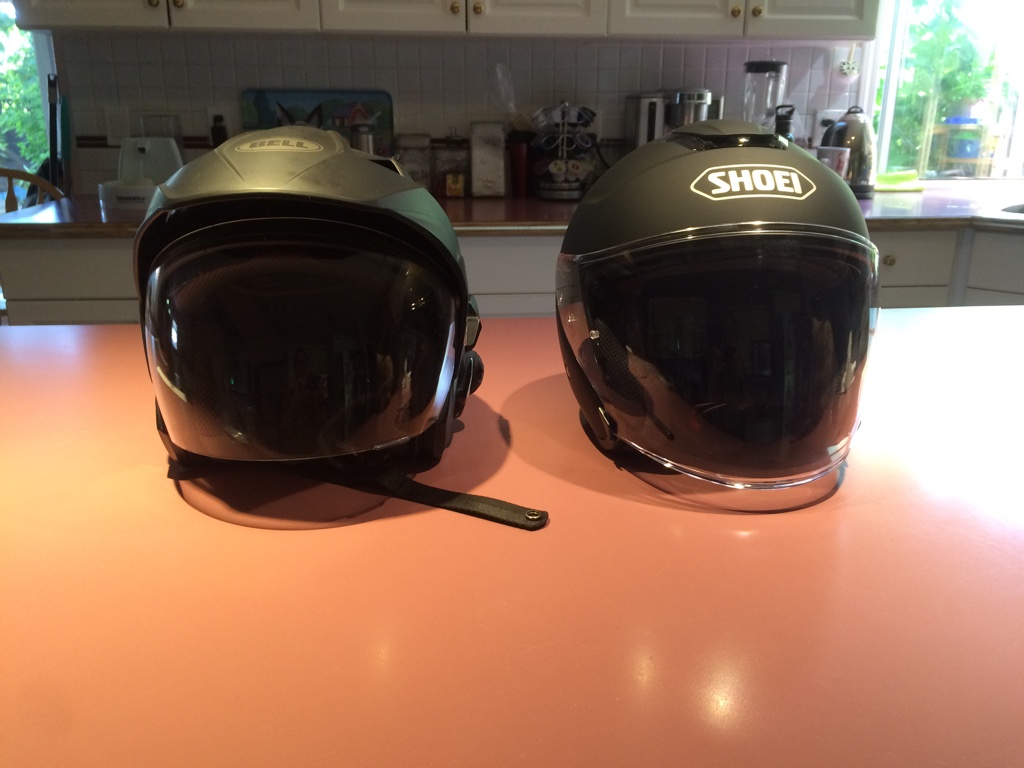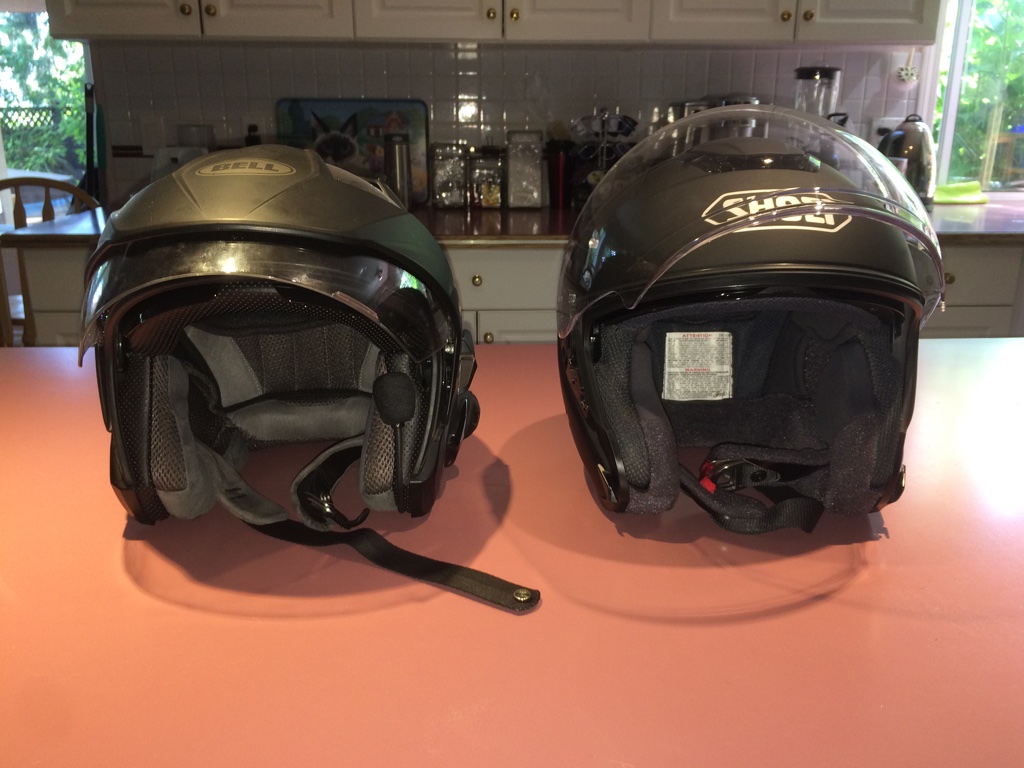Everyone who rides a motorcycle should wear a helmet. I am sure some people will disagree, and that is their right. But, and I mean no insult, wearing no helmet at all is foolhardy. I might even say going lidless is stupid. But hey, stupid is a choice sometimes too: and it is true that a helmet won’t save your life in every circumstance. Wearing a helmet doesn’t make you a super-hero, or indestructible, or even close to ’safe’. You are better off learning how to ride defensively all the time and going without a helmet than popping on a helmet and riding like an idiot. But if you want to go helmet free, you may as well stop reading now.
The freedom to wear or not wear a helmet isn’t the topic of this post. I assume you have already chosen to wear a helmet- good for you! I want to share my continuing journey towards the unachievable ‘perfect’ helmet, in the hopes that someone will benefit from my mistakes and discoveries. Because I have owned a lot of helmets over my past five years ‘back in the saddle’, and I’ve learned a few things along the way…
A word about safety…
The more of your head that is protected by a high-quality helmet, the safer you are. That’s all you really need to know: go buy a full face helmet that fits, and you are done.
If you are comfy with this, congratulations you need read no further
Someone has even helpfully calculated injury probability based on areas of the head potentially covered by a helmet:
So… choose a 3/4 helmet (one without a chin bar) and you have immediately lost about 34% of your protection from head injury in an accident (19.4% on the right side, and 15.2% on the left side). A half helmet with no face shield drops the protection by another 20%. A super-small beanie that doesn’t have a hope of proper DOT certification drops you another 24% or so. So those little beanie helmets you see some guys wearing? They give about 12% of the protection that a full-face helmet does.
I said I wouldn’t get into the argument about not wearing a helmet at all. I can’t really stick to that, but I’ll try to rein it in. A lot of folks who are anti-helmet make fully reasoned comments to the effect that a helmet won’t save your life at highway speed- absolutely, that’s true. But consider this: most motorcycle fatalities happen at about 25 miles per hour. How is that possible? Well, generally folks about to crash try really hard to slow down. By the time they “touch ground”, they are going a lot slower than they started out. At those kinds of speeds (i.e.: under 30 miles per hour) a helmet will absolutely make the difference between life and death in a high percentage of cases. Or catastrophic injury and minor injury. Wearing a helmet that provides the best protection you can tolerate is just common sense.
Of course, a helmet you won’t wear gives you 0% protection. So if you aren’t comfortable with a full-face helmet, you may make some compromises. Which is the position I started from: compromise.
Compromise… or who needs a chin, anyway?
The very first helmet I bought after getting back on a bike in 2010 was the Shoei Multi-tech. That’s the helmet on the far left in the picture above. It’s a full face helmet, but the chin bar has a swing up mechanism: this makes it easier to get in and out of for people like myself who wear glasses, and for people who are a little claustrophobic (also like me). It is a great, high quality helmet: it was also a mistake.
Suggestion #1: don’t spend a huge amount on your very first helmet
Shoei is one of the highest quality and most expensive helmet manufacturers out there. Arai is another at this top end: these are serious helmets made by companies with very large R&D units. Expect to spend well over $500 any helmet made by these companies- my Multi-Tech was over $700 Canadian, and some Arai helmets come in at about $1,000. They are a good investment… if you know exactly what you want.
If you aren’t sure what you want, and make the wrong choice, you end up with a very expensive tribute to your ability to over-spend. Instead, if you haven’t worn a helmet a lot recently and aren’t completely sure what you want, buy something from a less expensive manufacturer. I’ve had a lot of luck with HJC helmets: they are well made, reasonably comfortable, and inexpensive. I haven’t spent over $140 for any of the three HJC helmets I’ve owned: two of the helmets in my picture above are HJCs. But there are lots of other ‘low cost, good quality’ brands to try.
As I said, my first Shoei was a great helmet, but it wasn’t for me. The bike I bought was a cruiser, which puts me in a riding position (mostly upright, or leaning back) that means the chin bar is obstructing a good part of my field of view. I found that disconcerting: I had to constantly drop my chin to check my gauges, and it was a bit claustrophobic. I learned from this, and moved to another, less protective 3/4 style helmet within a matter of a couple of months.
Suggestion #2: try it on first
I love to shop on-line. I often find that I can get what I want more easily and often at a better price by web shopping. But fitting a helmet is very specific to the individual. Everyone has a different head, a different set of things that bother them or make them uncomfortable. Don’t start from day one with a helmet you hate: go and try several models and brands on at a dealer. Because that dealer just provided you a service, consider buying there… but at least try a particular helmet on before you commit to buying one like it.
Sizing and head shape come into play here. Even if the helmet you are picking is fantastic, it won’t work if it is too big or if it is designed for someone with a differently shaped head. If it wobbles around on your head, it will probably shift or fall off in an accident, rendering some or all of its ability to protect null. And although smaller is generally better, if it squeezes your head too much it will hurt right from the start, or you won’t even be able to squeeze your generously sized noggin into that little space at all.
Fortunately, try before you buy is one suggestion I adhered to from day #1. Every helmet I’ve owned, I tried on first at a dealer. Before I committed, I made sure that I was getting the right size, and that it didn’t poke or prod me too seriously.
No matter how comfortable a helmet feels at the dealer, once you’ve had a helmet for a while you are sure to find problems with it. Or at least you will if you are like me: a guy who regularly goes on multi-day road trips covering thousands of kilometres, and who is fussy as heck. Which leads me to my next suggestion…
Suggestion #3: be ready to try a new helmet periodically, and to own more than one
A helmet isn’t a marriage: you can abandon that piece of plastic and no one will be taking you to court or asking for alimony. This is even easier if you didn’t spend very much. And bear in mind that helmets, even the very best of them, have a shelf life. Literally. Even if you leave them on a shelf, the impact-protecting plastic foam in them breaks down over time. Most manufacturers recommend not using a helmet that is more than five years old. That means that expensive Shoei I bought back in 2010 is pretty much all used up, even though I only wore it for a couple of months.
One of the advantages to trying different helmets is that you may find perfection. Even if you don’t, you may find features you can’t live without, features that will help you pick a different helmet from a different company next time. I owned two HJC 3/4 helmets (one not shown in the above picture), and I love the flip down sun visor. So much so that I rejected going back to Shoei because they didn’t have that feature on their 3/4 helmets until recently.
Note that one of my helmets above is a HJC half helmet: the little guy, second from the left. I bought that helmet and wore it exactly twice. Half helmets give even less protection than 3/4 helmets, but I thought (don’t laugh) that they might make it easier to hear the stereo on my bike. I talk to all these Harley owners who say their stereos sound great, and I am here to tell you that they are full of baloney, have very low standards for audio, or both. Unless you are never exceeding about 30 miles per hour, the wind noise (to say nothing of the motorcycle noise) will over-power the music at almost any volume. To make it reasonably clear at highway speeds, you have to crank the volume to ear-busting levels: regardless of whether you are wearing a half helmet, 3/4 helmet, or full face helmet.
Suggestion #4: once you know what you want, buy the best you can afford
After trying five different helmets in five years, I’ve decided on the features I want:
- 3/4 helmet with face shield: this is the best compromise for me between comfort and protection
- flip down sun visor: I’d actually call this a safety feature- when the sun is blinding you, it can be a huge benefit
- aerodynamic: noise from poorly designed air flow can actually make a 3/4 or full face helmet louder than a half helmet, at least on a bike with a fairing (like mine)
3/4 Helmet Comparison: Bell Mag 9 vs Shoei J-Cruise
Knowing these things, I can compare my two most recent helmets:
Side- Left: Bell Mag 9 Sena; Right: Shoei J-Cruise
Front- Left: Bell Mag 9 Sena; Right: Shoei J-Cruise
Front Interior- Left: Bell Mag 9 Sena; Right: Shoei J-Cruise
Bell Mag 9 Sena
I bought the Bell last year as a bit of a gamble. The HJC IS-33 had been my ‘go-to’ helmet for several years, but had a few problems. Notably, the interior liner was a bit thin, and caused pressure points on my forehead. The Bell Mag 9 was a bit more comfortable, but it had a several drawbacks. Firstly, it is a noisy helmet. It looks aerodynamic, but I think it is more show than go: the wind noise in the Bell is significant. It also lacks an easy-to-detach face shield: the face shield needs to be washed regularly due to bug splatter, and making it easy to remove is important. Third, the Mag 9 has some problems with cooling. All modern 3/4 or full face helmets have some kind of cooling vents, but the ones in the Bell seem mostly decorative.
The ‘Sena’ part of the Mag 9 name indicates that this helmet comes pre-fitted and ready to accept installation of the Sena bluetooth headset communicator. I bought a Sena headset as well, but found that I didn’t use it very much. I don’t particularly want to listen to music when I’m riding, and have no wish to make or accept phone calls on my bike. The one thing I might use the headset for would be my GPS, and I’ve had difficulties keeping the thing paired properly. My experiences thus far with bluetooth motorcycle audio have been largely negative. This is the second headset system I’ve used, and there always seem to be pairing and audio stability issues. The last thing I want to be doing before (or worse, during) my ride is spending five minutes fiddling around with a recalcitrant piece of technology.
Shoei J-Cruise
The Shoei J-Cruise is a different kind of gamble. Shoei hasn’t had a 3/4 helmet with an integrated sun visor in the past so, although I know their product quality is superior, I haven’t gone back to them after my first Multi-tech purchase. The J-Cruise, though, has all the features I wanted: the gamble here is that Shoei is a ‘high end’ helmet company, and the J-Cruise is a $700 investment. Is it good enough to get that much more out of it?
Following Suggestion #2, I tried one on at a dealer- actually, since they didn’t have one in stock, I tried the full-face version of the same helmet. My walking-around-the-dealer test felt pretty good, so I decided to take the chance on the J-Cruise: at a minimum I knew I’d have the size right. Unfortunately, the dealer was going to take eight weeks to get a J-Cruise in: that wouldn’t help me as I had a road trip coming up in half that time. I found the helmet I wanted through a Canadian web dealer, Canada’s Motorcycle, and got it in less than a week. I’ve only ridden about 1,000 km with this helmet so far, but I can report the following: it is worth the money, for me at least.
The Shoei helmet is obviously wind-tunnel tested. It is much quieter than the Bell (or the HJC), and in particular the design of the face shield seems to reduce buffeting significantly. One note: the shield “locks” in place when closed, and can only effectively be opened with the left hand (or from the left side). This threw me off the first couple of times I was riding. The cooling in this helmet is great: better than any I’ve used before, providing a noticeable flow of air inside and over the top of my head.
The flip down visor works well: unlike the Bell, which basically has two positions, the Shoei sun visor is adjustable to nearly any position. It has no ‘one touch spring closed’ capability, but I have thus far found the simple hand control satisfying.
The fit is good, although it is currently pinching my cheeks a bit. This is arguably a good thing: proper 3/4 or full face helmet face is supposed to initially make you feel a bit like you might bite the inside of your cheeks if you aren’t careful, then gradually ‘wear in’. That said, it remains to be seen how this helmet feels after a good break-in period. One feature of the Shoei 3/4 helmets is that the bottom front edge extends a bit along the cheek, providing an extra fraction of the protection lost by not having a full face helmet. I suspect this is at least partly responsible for the tighter fit through the cheeks.
In general, the assembly quality of the Shoei largely explains the extra cost. The liner in particular is substantially thicker and provides better ’suspension’ of the helmet than either the Bell or the HJC IS-33. This means that the hard impact foam isn’t pressing down on the head noticeably. Despite the extra material, the Shoei and the Bell are almost exactly the same weight: about 1.5 kg for the Shoei, and about 1.6 for the Bell.
Conclusion
Motorcycle helmets are an important safety consideration, arguably the most important one after skills training to evaluate when getting on a motorbike. One size most definitely does not fit all when it comes to helmets, and that applies to the shape as well as the size itself. Don’t spend too much when you don’t know what you really want, but when you know what you want buy the best you can afford. Happy riding!

